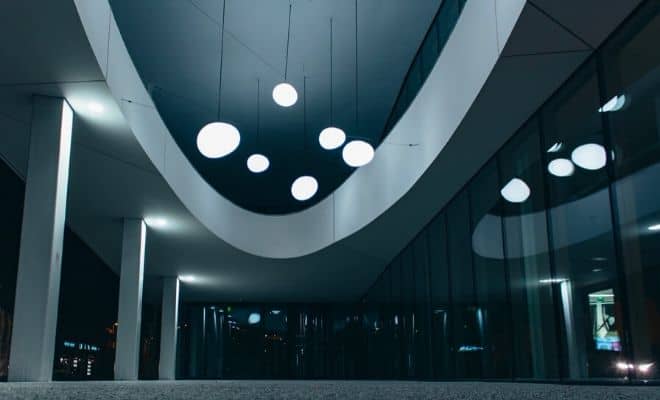Last Updated on April 2, 2020 by The Tutor
Lighting Design: The Rise of Human-Centric Innovations

When it comes to lighting design innovations, developing regions such as the Middle East are experiencing a double-digit growth curve, with revenues projected to US$8.7 billion by 2024. The rising popularity of energy-efficient LED in countries of the Gulf has added to the momentum, while recovering oil prices, stable consumer purchase power and expanding construction sector stimulate the growth.
Industrial and commercial lighting accounted for a total of 70% of the last year’s market, with high demand recorded by office spaces, malls, showrooms, and retail outlets. But what is the essence of this rising trend?
Technology leads the way
Lighting is a sector that rapidly adapts to the technological advances in the construction and building industry. With built-in sensors, light fixtures are becoming more intelligent, while wireless control options are becoming a standard feature of connected buildings. These solutions improve the occupier’s experience and allow for easier data management and analytics.
Unseen lighting design innovations technology
It can be argued that the most requested technology is the one that can’t be seen, as clients want interactive, dynamic, and kinetic lighting, but also want that all that magic is happening without being seen.
A perfect example is a sparkling wall that has become a popular feature in many hotels. These systems allow for light movements in connection with music, and even videos to be shot via the mobile and uploaded to the wall with a special application.
The lighting scheme of the crystal stones that make up the wall can be changed, so in combination with the ease of changing scene, it allows for full customization for the hotel.
More accessible lighting systems
Connectivity seems to be one of the biggest driving factors in lighting design innovations, as more resources are being spent on software development. The future systems are expected to be more accessible and have their artificial intelligence. However, the true meaning of “smart” is still in its infancy, but its huge potential cannot be denied.
Another big influencing factor is scale, as manufacturers are moving away from conventional lamp designs and starting to miniaturize the fixtures as a response to the prevalent use of LEDs.
Innovative lighting for public and commercial spaces
With offices experiencing yet unseen shifts in the way they operate, along with the preferences of the modern workforce, lighting has been moving to accommodate the changes. Assigned desks have given way to hot-desking that promotes space efficiency, which highlights the importance of connected task lighting that allows for plenty of flexibility.
Understanding the importance of ergonomic lighting in working environments can help people choose the appropriate lighting for their specific needs.
Commercial spaces like shopping malls are also trying to redefine the concept of comfort for their customers, and choosing the right lighting sources and properly arranging them is among their top priorities to this end, as it can also be used to facilitate their branding efforts.
According to a current master in interior design for commercial spaces, future designers should have absolute freedom to experiment and create, proving answers through their design solutions.
The amazing potential of LED lighting
The LED technology has revolutionized lighting digitalization. Both indoors and outdoors, LED products can be managed and modulated by control systems that apart from switching between predefined scenarios, also allow luminous flux to be adapted per application that brings up those needs.
When it comes to the illumination of spaces, dynamic lighting is what often comes into play. For example, LED lighting can be managed so that it enhances the visitor experience and guide them thought the store layout.
Industry-specific considerations
Apart from building compliance laws that such space needs to follow, for many hospitality and education venues, lighting is a part of the interior architecture and aesthetics that fits the overall design concept. In hotels, for example, an adjustable color temperature fixture can be used to provide cool lighting during breakfast, while in the evening a warmer light temperature can set the mood for a more relaxed atmosphere.
With the integration of beacon technology, store managers can get to know which shelves are most visited, and collect plenty of data to analyse trends and shopping habits.
Lighting’s impact in health and well being
With increased control over color and lighting intensity, people’s well being is becoming a focal point in lighting design, especially in the workplace. Apart from adjusting the color temperature to respond to the time of day, human-centric lighting aims to use interactive lighting installations that bring people together with one another, not with technology.
Recent discoveries on non-imaging cells within the retina have found out that blue light is disruptive at night, prompting designers to find solutions that synchronize biological time with social time, now made possible with intelligent tech.
Advanced lighting design innovations allow us to implement lighting schemes that until recently existed only on draft boards. More importantly, the flexibility and ability to control the light color and luminous flux have given connectivity a whole new meaning, with the immersive occupant, guest, or customer experience.
There has also been a recent focus by consumers in finding non toxic LED light bulbs for their homes. You can expect that trend to continue into commercial spaces as well.
Related Articles
Is Recessed Lighting Going Out of Style?
